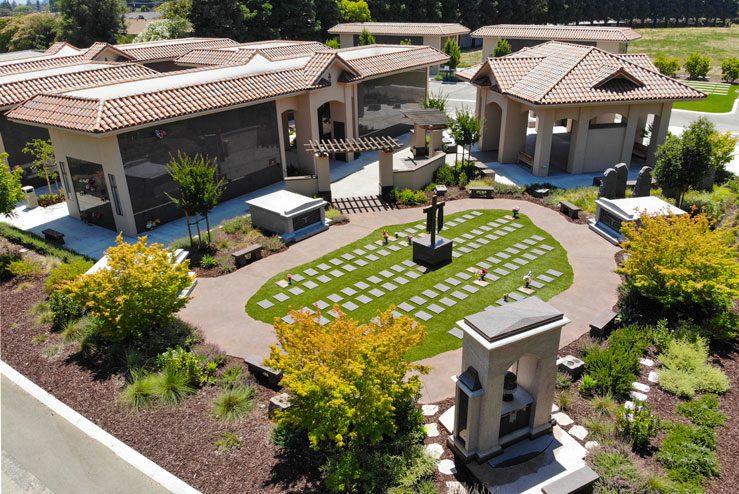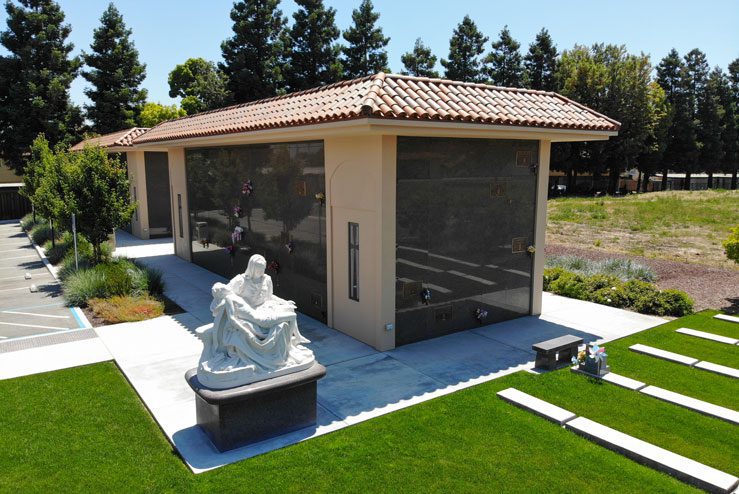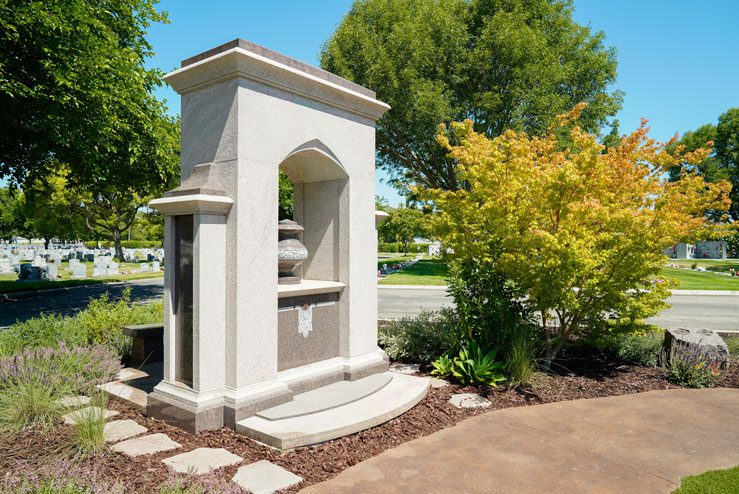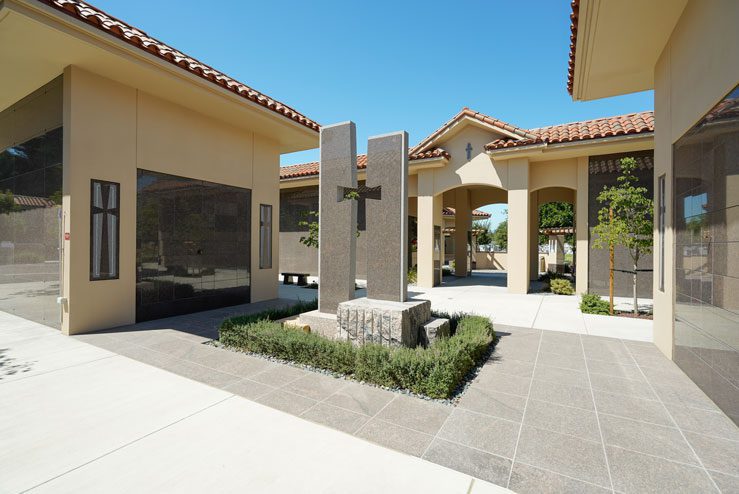
Santa Clara Mission Cemetery in Santa Clara, CA — The 59-acre cemetery, which traces its roots back to 1859, was running out of crypt space in its St. Joseph Mausoleum. “We are a cemetery that consistently sells crypts to families,” Bruton said. “We knew we needed to do something.”
It was easy to understand why families were drawn to the mausoleum. With more than 2,800 single, double and four-place aboveground crypts on two levels, the interior is filled with beautiful artwork of historic Santa Clara Valley, stained glass, painted tiles and paintings of St. Joseph, the Sacred Heart, Our Lady of Fatima, St. Patrick, St. Peter and St. Paul, St. Robert Bellarmine and others.


To make the project a reality, Bruton turned to Coldspring. “They understood what we wanted to do,” Bruton said. Adding a cremation burial garden, outdoor committal shelter and onsite parking, along with a beautifully designed complex area would be a paradigm shift for the cemetery, Bruton acknowledged, but one that would meet the needs of families today and in the future.
When Santa Clara Mission Cemetery opened in 1859, the Jesuit community of Santa Clara operated it, and not much long-term planning was done.
Not surprisingly, while not much was around when the cemetery was established, over time the area has built up. “We’re a landlocked cemetery,” Bruton said. “We couldn’t expand out, so we needed to identify areas within our grounds that would work for the project,” he said. “We still have a fair amount of development (space) left, so the key was finding the right space for what we envisioned.”
That vision, Coldspring designer Justin Piepenburg said, was to create an inviting space for families while also providing a variety of memorialization options. The goal, he added, was to “add crypt spaces while bringing in a modern and authentic mission-style design to give the cemetery a new look.”
Although there is no longer a formal connection with the Jesuit community, the cemetery enjoys a close relationship with Santa Clara University, a private Jesuit university, located within a few minutes walk of its grounds. Design inspiration came from the Spanish missions and Southwest architecture that are integral parts of Santa Clara, Piepenburg, and Coldspring project manager Jim Hartman pointed out.


“The materials were chosen to promote the beauty and longevity of the site,” Piepenburg said. “Special attention was placed on creating a natural setting without compromising the integrity and order of Spanish Mission and Southwest architecture.” The granite colors chosen, Hartman added, were specific to offering a soft, yet warm, tone that shared the mission feel. Equally important, Hartman and Piepenburg said, was to tie the project into the St. Joseph Mausoleum and to respect and bring attention to the mission and the relationship with Santa Clara University.
Bruton agreed. “We didn’t want something that stood out,” he said. “Rather, we felt it was important to integrate seamlessly into the landscape. It’s definitely a new design in an old cemetery, but it looks and feels like it belongs.”
And in developing the mausoleum complex, the cemetery is able to offer families a variety of options within a limited space. “Consumer preferences are changing,” Bruton pointed out. “Today’s consumers want choices … and for continued success you have to evolve.”
Part of that evolution process for Santa Clara Mission Cemetery was the establishment of a cremation garden. “It was a leap of faith for us,” Bruton said. “But families are embracing it. We installed 100 spaces, and we’ve already sold more than 50% (of the spaces).”
Another “first” for the cemetery was the mixed-use shelter, which can be used as an outdoor receiving area for committal services. “We felt that it was important to offer families an outdoor beautiful space,” Bruton said. “Again, it was listening to what families were asking for and responding to those needs.”
The new complex also offers onsite restrooms, storage and parking, things that have been quickly embraced by cemetery staff and families. “They were never considered in previous projects,” Bruton said.


It was a tour of the Coldspring’s facilities by Bruton that secured the cemetery’s bronze business for the company, Hartman said, and allowed for the development and creation of a unique and innovative design and offering for bronze.
“The plaques have been very well received by our families,” Bruton said. “Beyond the personalization (with the name), it gives them the ability to touch and feel the bronze and make that connection with their loved one.”
The project is a win-win for both Santa Clara Mission Cemetery and the families it serves. For the cemetery, the complex is providing new interest and inventory while saving space and maximizing interment opportunities. With its more modern design, it’s appealing to families who want choices, and at the same time creating new revenue and providing dynamic sales opportunities across budgeting options.
For families, the complex offers a number of memorialization options at a variety of price points. “There’s something for everyone,” Bruton said. “In this complex, it’s all about choice … from the type of burial to the products available for permanent memorialization.”


“We’re a traditional cemetery, so adding something like this was a calculated risk,” he said. “But it works because we listened to what our families were asking for and we were able to deliver something that was new and exciting that is able to meet their needs. We’re excited, our families are excited … it’s good all around.”
Article c/o American Cemetery & Cremation Magazine